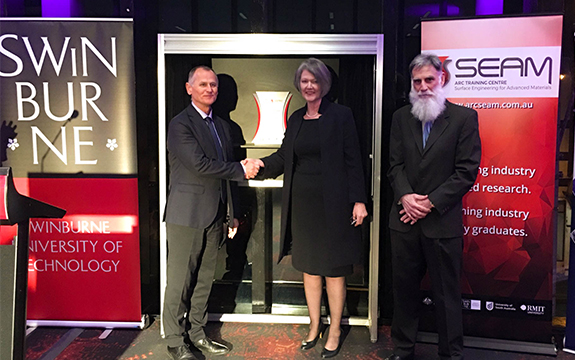New ARC training centre boosts Australia’s manufacturing industry and workforce

In Summary
- The ARC Industrial Transformation Training Centre in Surface Engineering for Advanced Materials (SEAM) has launched at Swinburne
- The Swinburne-led centre will help solve critical surface engineering problems faced by industry
- SEAM will provide pathways for job creation and ensure a high-quality manufacturing workforce
The Australian Research Council (ARC) Training Centre in Surface Engineering for Advanced Materials (SEAM) has been officially launched at Swinburne. It is the largest manufacturing research and development centre of its kind in Australia.
Swinburne has received $4.9 million from the federal government to lead the centre, in collaboration with the University of South Australia and RMIT University and 29 industry partners.
The ARC SEAM Centre will work with industry to solve surface engineering problems and develop new products to improve the service life or function of a component’s exterior by adding functionalities such as corrosion resistance, antibacterial properties or wear protection.
Solving surface engineering problems
SEAM aims to solve crucial surface engineering problems to enable the Australian manufacturing industry to be more efficient and profitable in the global marketplace.
The estimated cost of wear and corrosion is up to 5 per cent of the Gross Domestic Product (GDP) of a country like Australia. Sophisticated surface coatings technology is in high demand, especially for industries such as the medical device market which is expected to grow at 4.5 per cent per annum.
The SEAM team of more than 77 researchers and industry leaders will investigate the gaps in surface engineering across 13 projects over the next five years. Each of the projects addresses a specific need faced by an industry partner, some of which include:
- Refurbishment and remanufacturing of large, high value components for the mining sector
- Developing antibacterial films for medical implants to help control infection
- Helping the aerospace and automotive industry minimise downtime, using metal additive manufacturing to rapidly repair damaged components
- Improving the surface for parts in marine vessels to minimise corrosion and extend their length at sea
A training ground for the future workforce
SEAM also provides pathways for job creation and ensures a high-quality workforce in manufacturing through the training of future staff.
Swinburne students and postgraduate researchers will spend up to a year with an industry partner working on a project to gain valuable experience and potentially long term career opportunities.
Distinguished Professor Chris Berndt leads SEAM at Swinburne and says the centre will help create a healthy pipeline of industry-fit professionals.
“Often we receive feedback from industry that it can take up to 12 months or more to train up a new employee. The concept for SEAM is to provide the surface engineering industry with ‘plug and play’ graduates. SEAM graduates will have the necessary knowledge and basic skills in surface engineering to help their employees without the steep learning curve. SEAM really does cover it all,” says Professor Berndt.
The SEAM difference
Minister for Education, The Hon Dan Tehan MP, says SEAM will help drive a strong local manufacturing industry which is vital to the future prosperity of Australia.
“The research done by our universities can lead to the development of new products and innovations that drive job growth, business opportunities and productivity gains,” he says.
Deputy Vice-Chancellor (Research and Development), Professor Aleksandar Subic, says SEAM is built on Swinburne’s world class capability in advanced manufacturing and materials.
“Through this national industry research training centre we will be working closely with our industry partners and research collaborators to create impact on scale through development of a new generation of research workforce that will be embedded in industry. This is consistent with our impact oriented strategy that aims to transform industries and shape lives and communities.”
Find out more about the ARC SEAM Training Centre.

